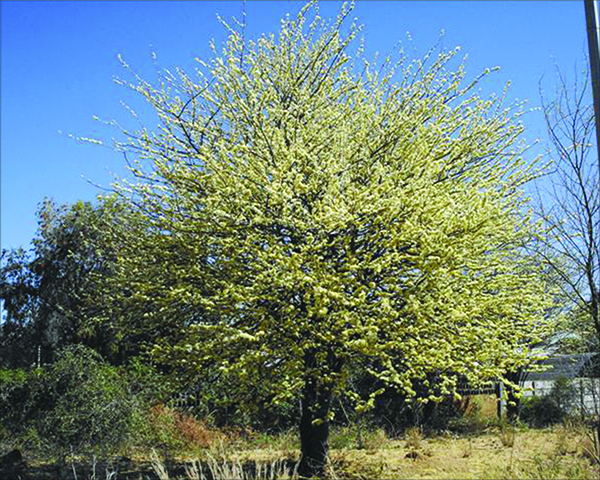• LUISE HOFFMANNNAMES: G. Wurmrindenbaum, Kirschblütenbaum; A. aruboom, oumahout, kersieblomboom; H. Omuama; The genus name Albizia refers to an Italian nobleman who first described the tree, the species name anthelmintica indicates that the tree is used as a worm-cure.
THE worm-cure albizia is conspicuous from July until November when its sturdy, dark, bare branches are thickly covered with large cream-coloured, powder-puff-like flowers, giving the tree an exquisitely graceful appearance. The flowers consist of numerous cream-coloured stamens up to 2,5 cm long. Quite young trees already bear flowers. People of European descent upon seeing these trees in flower were reminded of flowering cherry trees, hence the German and Afrikaans common names.
Another identifying feature is the fairly smooth dark grey to reddish bark, which turns rough and fissured on old trees. The branchlets often have spine-tipped lateral shoots. The general appearance of young worm-cure albizia tree is much like that of the blackthorn (Acacia detinens) but the worm-cure albizia has no thorns.
The worm-cure albizia is very wide-spread and common from around Keetmanshoop and Maltahöhe northwards throughout the whole of Namibia with the exception of the true desert areas. It grows everywhere on the hills around Windhoek, along streets and in gardens of the capital.
A particularly large and beautiful specimen can be seen in the old cemetery on the eastern side of Robert Mugabe Ave.
The worm-cure albizia can be a shrub or a single-stemmed tree up to 8 m high. The twigs are quite thick and end rather abruptly, a feature clearly visible when the tree is bare. The soft reddish-brown bark with oval whitish lenticels is frequently gnawed by animals that seem to instinctively know that it is a cure for intestinal parasites.
Only after the flowers have wilted and the flat, straw-coloured pods have formed do the twice compound leaves appear.
They are similar but considerably larger than those of the balck-thorn (Acacia mellifera), with which the tree could easily be confused if it were not for the numerous hooked thorns borne by the latter. In autumn the leaves turn a lovely golden yellow.
Over most of the African continent the pulverised bark of this tree is used as a cure for intestinal parasites in man and beast. The foliage is eagerly browsed and the twigs of young trees often appear severely chewed.
Dassie and porcupine gnaw the trunk; elephant strip the bark and the twigs.
The white-browed sparrow-weaver and the red-billed buffalo-weaver nest in them, while sunbirds visit the flowers and baboons and armoured ground crickets eat the leaves. The gum is good to eat and small branches are used as toothbrushes.
Gardening: This beautiful tree is frost and drought resistant, has lovely flowers in spring, followed by interesting pods and a dark green crown in summer as well as beautiful golden leaves in autumn. Protect and cherish it if you find it on your street or on your property. Seedlings are available from the nursery at the NBRI and possibly at your local Forestry nursery.
This tree is protected by forestry legislation.
Stay informed with The Namibian – your source for credible journalism. Get in-depth reporting and opinions for
only N$85 a month. Invest in journalism, invest in democracy –
Subscribe Now!






